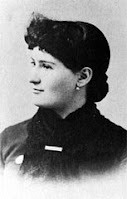 |
| activerain.com |
Back in the day of guns, gambling, and girls, Jennie Rogers was one of Denver’s most popular and richest madams. Alongside friend and rival Mattie Silks, men seeking a break from panning for gold or just wanting female company would seek out one of the two famous houses along Holladay street. Located in downtown Denver and named after Ben Holladay, the street’s name was changed to Market Street after Holladay’s heirs petitioned city council for the change as the street had gained an unsavory reputation throughout the west.
Described as the most beautiful of all the madams on Holladay Street, Jennie hailed from Pennsylvania. Born on July 4th in Allegheny, her given name is thought to be Leah Weaver or Leah Tehme. Her father was farmer John Weaver and she aided the family’s income by selling produce in Pittsburgh’s market area. It was there that she caught the eye of Doctor G. Fries. The two married but with Fries’ job keeping him from home too many instances, Jennie eventually left the marriage and took to traveling the waterways in Pennsylvania and Ohio where she met a steamship captain. She tired of that relationship, and around circa 1870 she took a position as maid to Pittsburgh’s mayor, but when rumors began to circulate regarding her unsavory past, the mayor, though he liked Jennie, was forced to let her go, lending her a large amount of money so she could start her own business. She did, opening her first parlor house in St. Louis.
Jennie’s house in St. Louis was a success, but she eventually heard of the gold and silver rushes happening in Colorado and moved to Denver. Her first house on Holladay Street she purchased from Mattie Silks for $4,600. She made that money back in less than a month, but Jennie’s house wasn’t run as cleanly as Mattie’s. Customers were arrested for smoking opium, some of her girls were arrested for the same and for stealing, and with society women in an uproar over the red light district, 1886 saw the law cracking down on the parlor houses. Unfathomed by this, Jennie went on to improve her house. Hating the stench hanging in the air of her home from stale perfume and cigars, Jennie was the first madame to open her windows and let in the fresh air, installing bars over the windows so her girls couldn’t admit a man they favored for free. She added fresh wall paper and paint and went on to purchase the house next door, where she joined the two by having a walk knocked out.
Jennie was involved in numerous scandals, most of which are attributed to gossip, with her most famous one involving her wanting to purchase an even bigger house. It was said she had a boyfriend in St. Louis who was the police chief. When Jennie was ready to buy a larger house, wealthy Denver businessman George Splevin was running for governor. Splevin gained his wealth from taking over the company he currently owned and by marrying the former owner’s wife. Rumors abounded regarding Splevin’s first wife as she just seemed to disappear, so Jennie’s boyfriend concocted a blackmail scheme where he buried a skull in Splevin’s backyard and had the ‘D.A.’ dig it up, claiming it to belonged to Splevin’s first wife. In exchange for the charges being dropped, Splevin gave Jennie the $17,000 she need to buy her new house.




No comments:
Post a Comment